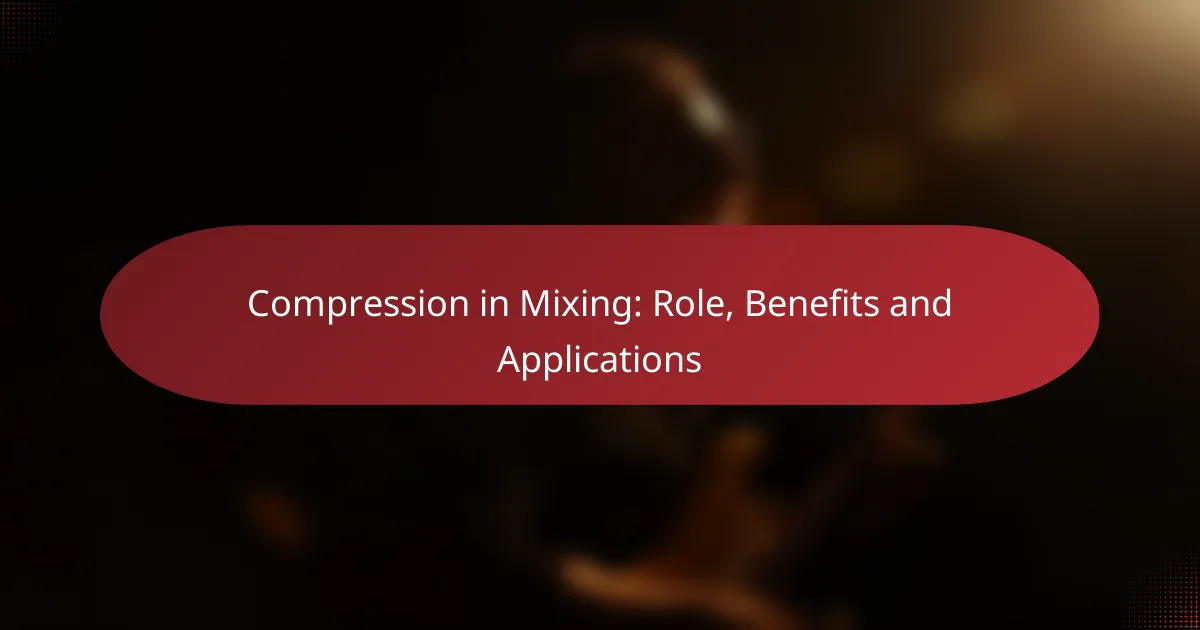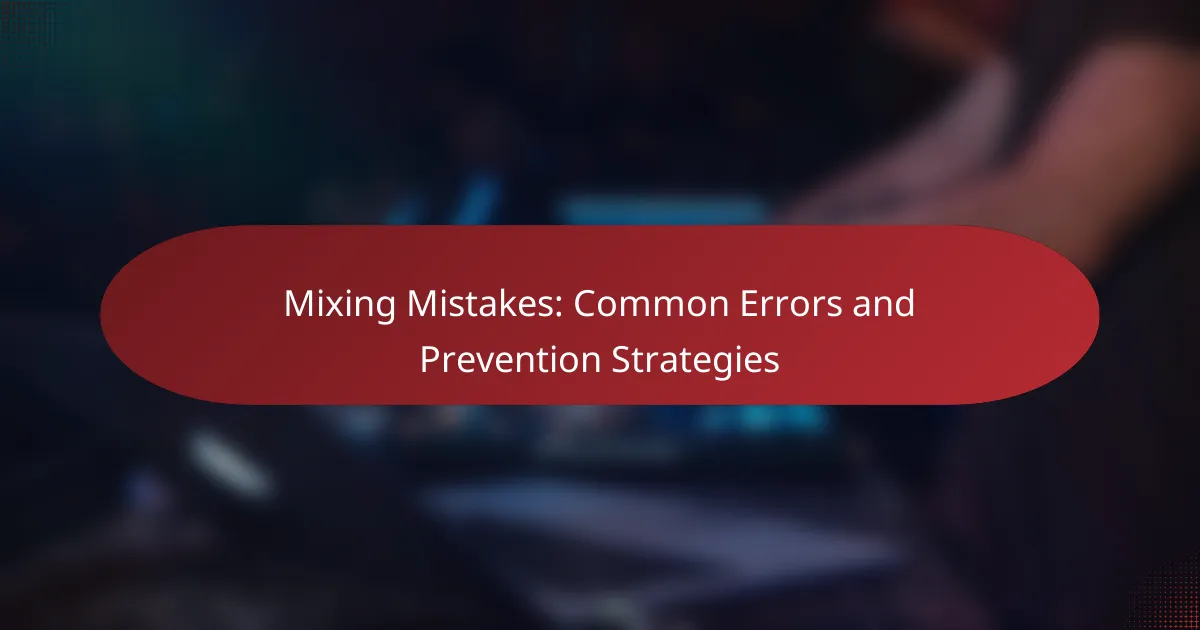Compression plays a crucial role in audio mixing by managing the dynamic range of sound, making quieter elements more audible while preventing louder ones from dominating the mix. This technique not only enhances sound quality and clarity but also contributes to a more cohesive and professional final product. Various compression methods, such as parallel and sidechain compression, can be employed to achieve specific effects and improve overall mix dynamics.
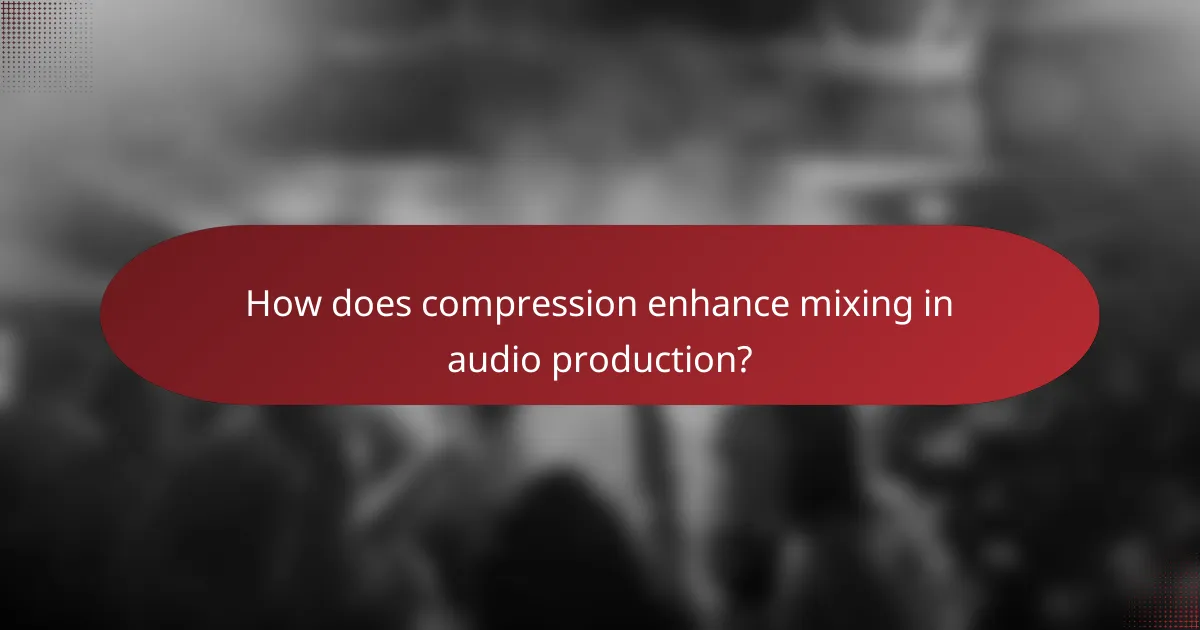
How does compression enhance mixing in audio production?
Compression enhances mixing in audio production by controlling the dynamic range of audio signals, ensuring that quieter sounds are audible while preventing louder sounds from overwhelming the mix. This results in a more polished and cohesive sound that is easier to balance and manipulate during the mixing process.
Dynamic range control
Dynamic range control is a primary function of compression, allowing audio engineers to manage the difference between the softest and loudest parts of a track. By reducing the volume of peaks and boosting quieter sections, compression helps maintain a consistent sound level throughout the mix. This is especially useful in genres like pop and rock, where vocal clarity is essential.
When applying compression, aim for a ratio between 2:1 and 4:1 for moderate control. Adjust the threshold to ensure that only the loudest parts are affected, preserving the natural dynamics of the performance.
Improved clarity
Compression can significantly improve clarity in a mix by allowing individual elements to be more distinct. By leveling out the volume of various instruments and vocals, compression helps prevent any single element from masking others. This is particularly important in dense mixes where multiple sounds compete for attention.
To enhance clarity, consider using a fast attack time to catch transients and a medium release time to allow the sound to breathe. This approach can make vocals and lead instruments stand out without losing their natural character.
Consistent levels
One of the key benefits of compression is achieving consistent levels across a mix. This ensures that no part of the track is too quiet or too loud, making for a more enjoyable listening experience. Consistency is crucial for maintaining listener engagement, especially in longer tracks or albums.
When setting up compression, aim for a gain reduction of around 3-6 dB for most instruments. This subtle adjustment can help maintain a balanced mix without sacrificing the dynamic feel of the performance.
Enhanced punch
Compression can enhance the punch of a mix by emphasizing the attack of instruments, making them feel more impactful. This is particularly beneficial for drums and bass, where a strong attack can drive the rhythm and energy of a track. By carefully adjusting the attack and release settings, you can create a more dynamic and engaging sound.
For a punchy sound, use a fast attack time to catch the initial transient of the sound and a quick release to allow the body of the sound to come through. This technique can add excitement and energy to your mix.
Balanced frequency response
Compression contributes to a balanced frequency response by controlling the levels of different frequency ranges within a mix. By managing how each element interacts with others, compression helps prevent frequency clashes that can muddy the overall sound. This is essential for achieving a professional-sounding mix.
To maintain a balanced frequency response, consider using multiband compression, which allows you to target specific frequency ranges independently. This can be particularly useful for taming harsh frequencies in vocals or enhancing the warmth of bass instruments without affecting the overall mix.
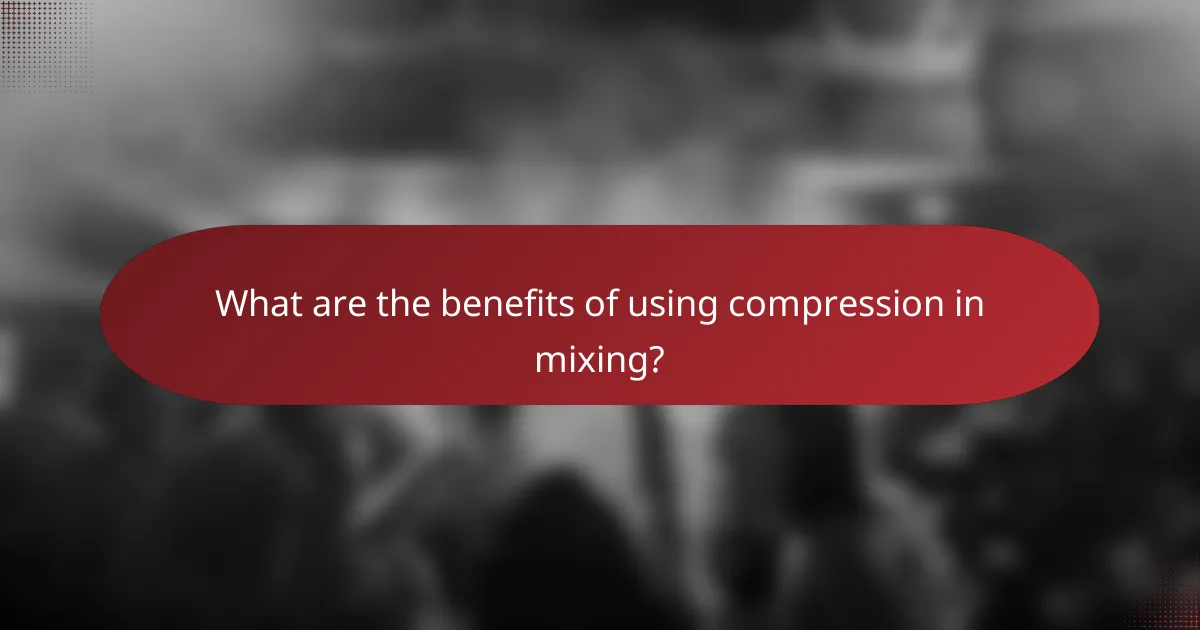
What are the benefits of using compression in mixing?
Compression in mixing offers several advantages, including enhanced sound quality, improved clarity, and better control over audio dynamics. By managing the dynamic range of audio signals, compression helps create a more polished and professional mix.
Prevention of distortion
Compression helps prevent distortion by controlling the peaks in audio signals that can exceed the limits of the mixing system. When levels are too high, distortion can occur, leading to an unpleasant listening experience. By applying compression, you can keep audio levels within a manageable range, ensuring clarity and fidelity.
It’s essential to set the threshold and ratio appropriately to avoid over-compression, which can lead to a lifeless sound. Aim for a moderate ratio, typically between 2:1 and 4:1, to maintain the natural dynamics of the audio while preventing distortion.
Increased loudness
One of the primary benefits of compression is the ability to increase the overall loudness of a mix without introducing distortion. By reducing the dynamic range, quieter sounds can be brought up in level, making the mix sound fuller and more powerful. This is particularly useful in genres like pop and rock, where loudness is often a key factor.
To achieve optimal loudness, consider using a combination of compression and limiting. While compression can help balance levels, a limiter can ensure that the final output does not exceed the desired loudness threshold, typically around -1 dB to -0.5 dB for digital formats.
Improved instrument separation
Compression can enhance instrument separation in a mix by controlling the dynamics of individual tracks. When each instrument is compressed appropriately, it allows for clearer distinction between sounds, making it easier for listeners to identify each element. This is particularly important in dense mixes where multiple instruments compete for attention.
Utilizing sidechain compression can further improve separation by allowing certain elements, like vocals, to stand out against the backdrop of other instruments. This technique involves compressing one track based on the level of another, creating space and clarity in the mix.
Control over transients
Compression provides control over transients, which are the initial peaks of sound that can be sharp and sudden. By managing these transients, you can create a more balanced and cohesive mix. This is especially useful for percussive instruments, where transients can dominate the overall sound.
When applying compression, consider using a fast attack time to tame aggressive transients while allowing the body of the sound to remain intact. Experiment with different attack and release settings to find the right balance that maintains the energy of the performance without overwhelming the mix.
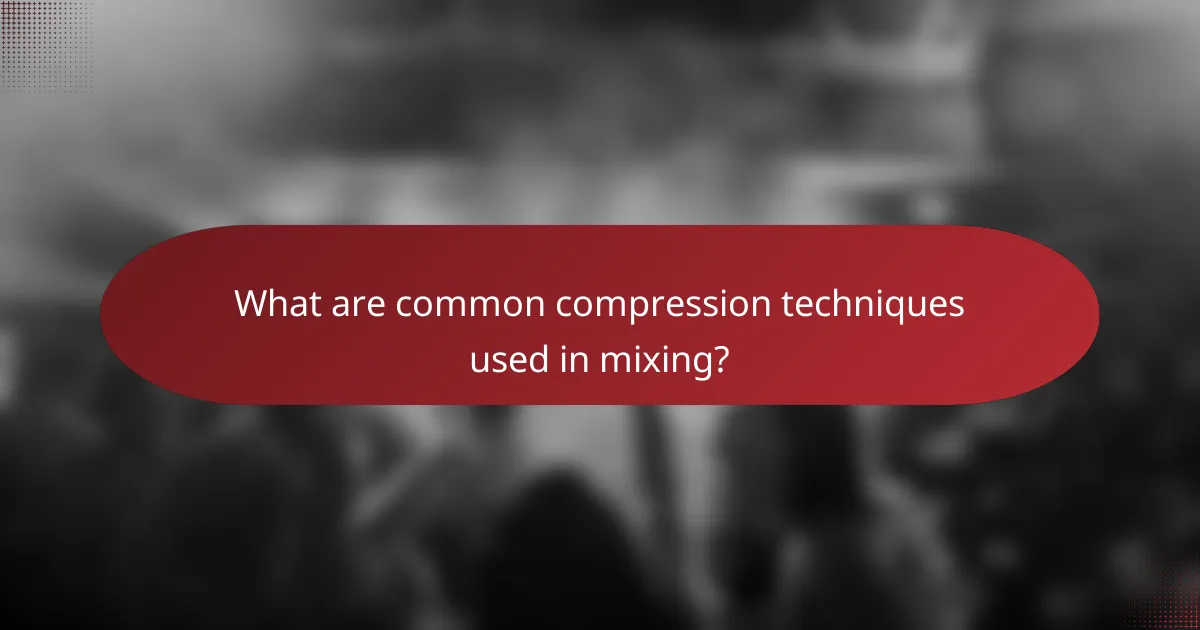
What are common compression techniques used in mixing?
Common compression techniques in mixing include parallel compression, sidechain compression, multiband compression, and vocal compression. Each technique serves specific purposes and can enhance the overall sound quality of a mix by controlling dynamics and adding clarity.
Parallel compression
Parallel compression involves blending a heavily compressed signal with the original, uncompressed signal. This technique allows for increased loudness and sustain while retaining the natural dynamics of the audio. It is particularly effective for drums and vocals, where the goal is to enhance presence without losing the original character.
To apply parallel compression, route the audio signal to two channels: one for the original sound and another for the compressed version. Adjust the levels to find the right balance, typically starting with a ratio of around 4:1 on the compressed channel.
Sidechain compression
Sidechain compression is a technique where the compressor is triggered by an external signal, often used to create a “pumping” effect in music. This is commonly applied in electronic music to allow the kick drum to cut through the mix by lowering the volume of other elements when the kick hits. It enhances clarity and rhythm in a track.
To implement sidechain compression, set up a compressor on the track you want to affect and use the kick drum as the sidechain input. A ratio of 4:1 to 8:1 is often effective, with a fast attack and release time to achieve the desired effect.
Multiband compression
Multiband compression divides the audio signal into multiple frequency bands, allowing for independent compression settings for each band. This technique is useful for addressing specific frequency issues without affecting the entire mix. It can help control harshness in the high frequencies while maintaining warmth in the lows.
When using multiband compression, choose frequency ranges that correspond to the elements in your mix. For instance, you might compress the low band more aggressively while applying lighter compression to the mid and high bands. This targeted approach can enhance clarity and balance.
Vocal compression
Vocal compression focuses on controlling the dynamics of vocal tracks to ensure they sit well in the mix. It helps maintain a consistent volume level, making the vocals more present and intelligible. Common practices include using a moderate ratio, typically around 3:1 to 5:1, with a fast attack time to catch peaks.
For effective vocal compression, consider the vocal style and genre. For softer singing, a gentler compression approach may be suitable, while more aggressive styles might benefit from heavier compression. Always listen critically to ensure the vocal maintains its natural character.

What tools are essential for compression in mixing?
Essential tools for compression in mixing include various hardware and software compressors that help control dynamics, enhance sound quality, and achieve a polished mix. Each tool offers unique features and characteristics that can significantly impact the final sound.
Universal Audio LA-2A
The Universal Audio LA-2A is a classic optical compressor known for its smooth, natural compression. It excels in vocal and instrument applications, providing a warm tone while maintaining clarity. Its simple interface allows for quick adjustments, making it ideal for both beginners and experienced engineers.
When using the LA-2A, aim for a gain reduction of around 3-6 dB for subtle compression. Be cautious not to over-compress, as this can lead to a loss of dynamics and liveliness in the mix.
Waves SSL G-Master Buss Compressor
The Waves SSL G-Master Buss Compressor is designed to glue mixes together, offering a punchy and cohesive sound. It emulates the renowned SSL console’s bus compressor, making it a favorite for final mix processing. Its ability to add warmth and presence while controlling peaks is highly valued.
For effective use, set the threshold to achieve 2-4 dB of gain reduction during the loudest passages. Adjust the attack and release settings to suit the material; faster settings can enhance punch, while slower settings can smooth out transients.
FabFilter Pro-C 2
FabFilter Pro-C 2 is a versatile digital compressor with advanced features and a user-friendly interface. It offers multiple compression styles, including clean, classic, and pump, allowing for tailored dynamics processing. The visual feedback helps users understand compression behavior in real-time.
Utilize the sidechain feature to control compression based on other audio signals, enhancing clarity in dense mixes. Experiment with the auto-release function to adapt the release time dynamically, ensuring a more musical response to the audio material.
iZotope Ozone Dynamics
iZotope Ozone Dynamics is part of the Ozone mastering suite, providing comprehensive dynamics control for final mixes. It includes multiband compression, allowing for targeted processing across different frequency ranges. This tool is particularly useful for mastering, where precise control is essential.
When using Ozone Dynamics, consider applying gentle compression on the master bus, typically around 1-3 dB of gain reduction. Use the multiband feature to address specific problem areas, such as controlling low-end rumble or taming harsh highs without affecting the overall mix balance.

How to choose the right compressor for your mixing needs?
Choosing the right compressor for mixing involves understanding your specific audio requirements and the characteristics of different compressors. Key factors include the type of sound you want to achieve, the dynamics of the audio material, and the compressor’s features.
Understand the types of compressors
There are several types of compressors, including VCA, FET, optical, and tube compressors, each offering unique sonic qualities. VCA compressors are versatile and often used for their precision, while FET compressors provide a punchy sound ideal for drums. Optical compressors are known for their smooth response, making them suitable for vocals.
Consider the audio material
The type of audio you are mixing significantly influences your compressor choice. For instance, vocals may benefit from a slower attack time to maintain natural dynamics, while drums often require a fast attack to control transients. Experimenting with different settings can help you find the best fit for your specific tracks.
Evaluate key features
When selecting a compressor, look for essential features such as attack and release times, ratio settings, and make-up gain. A compressor with adjustable attack and release times allows for greater control over how it interacts with the audio signal. Additionally, a higher ratio can provide more aggressive compression, which may be desirable for certain genres.
Set a budget
Compressor prices can vary widely, from affordable software plugins to high-end hardware units. Determine your budget early on to narrow down your options. Many quality plugins are available for under $100, while professional hardware compressors can range from several hundred to thousands of dollars.
Test before you buy
Whenever possible, try out compressors in a real mixing scenario before making a purchase. Many software companies offer demo versions of their plugins, allowing you to assess their sound and functionality. For hardware, visiting a local music store or rental service can provide hands-on experience.






